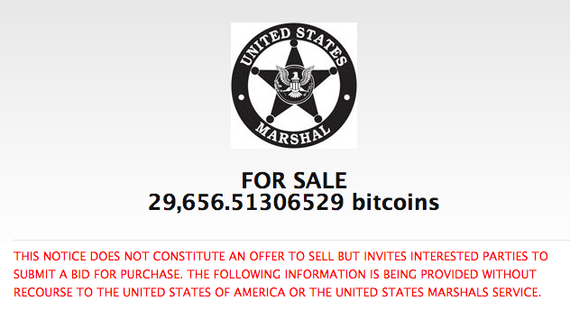
If you are still unfamiliar with bitcoin (BTC), a previous article here offers a good introduction to the digital currency. One of the biggest stories in the past year involving bitcoin, was the FBI’s seizure of 30 000 bitcoins from the online black market Silk Road. These bitcoins were the profits made by Ross Ulbricht, the man behind Silk Road, and the entirety was seized in October 2013 by the United States Marshal Services. This seizure catapulted the US government into being one of the largest holders of bitcoin, which presented an interesting problem.
The US government currently does not consider bitcoin a currency, but rather property. So this seizure of USD $18 million in digital currency could not be called a cash seizure by the USMS. The large block of money had to be treated as a commodity or property seizure, which meant a property auction carried out by USMS, and open to the public.
The USMS decided the best way to go about this was to split the purse into 30 auction blocks consisting of 1000 bitcoins, and have a secret ballot auction via email for each block. This alone was different from the way seized property auctions are generally conducted, but the purely digital nature of bitcoins meant that interested parties could bid with full confidence from anywhere.
There were, however, gates to participating in this auction. Anyone placing a bid had to deposit USD $200 000 with the USMS prior to the auction, as well as provide proof of funds. At market value on the day of the auction, each block was worth ~$620 000, so even the minimum deposit was nowhere near even the most pessimistic valuation.
Regardless of the $200 000 wall, anyone was able to email the USMS with questions regarding the auction, as it was open to the public. Despite holding an auction on a digital crypto currency, apparently the USMS hadn’t quite mastered email yet. In responding to one query, an email was accidentally replied to all, which sent a list of all parties who had expressed interest in the auction to every other party that had done the same. The private ballot got a little less private.

Although amusing, the number of interested parties was high enough at 41 that game theory essentially eliminated the threat of collusion. With that many parties, the likelihood of an individual party overbidding the agreed upon under market price by a tiny amount is too high. Still, when dealing with $18 million in a highly technical currency, this kind of shortcoming doesn’t breed confidence.
On June 27 the auction went live. Bidders were allowed to bid on as many blocks as they wanted, but only able to bid on each block once. Now who exactly are these bidders that are willing to spend upwards of $600 000 minimum to buy such a controversial currency? Up until recently, parties interested in bitcoin from an institutional standpoint have been limited. The high volatility and lack of regulation has scared most firms away, with very few exceptions, from holding any of the currency,. However, the extra legitimacy lent to this auction by the US government involvement would bring a few new interests.
SecondMarket and Pantera Capital are two investment firms that already have sizeable holdings in bitcoin, with SecondMarket offering a bitcoin ETF(Exchange Traded Fund). Both were looking to add additional coins to their holdings, and were expected to be the major players in the auction. The biggest surprises among the bidders were traditional financial institutions that were looking to dip their toes into the emerging market of digital currency. BNP Paribas, Rangely Capital, and Matrix Capital all looked to make initial purchases of bitcoin, a much different audience then what would be expected even a year ago, when bitcoin was still seen as a strictly black market currency.
Despite these big names and bigger wallets bidding on them, most were looking to find a quick arbitrage opportunity, and bid below market price in hopes of making a quick and easy profit. A few were looking to pay current market value, in hopes of acquiring a large amount quickly, as normally large purchases would inflate the price and therefore cost. Most analysts expected the blocks to be picked up for varying prices by different parties, with prices ranging from slightly below to slightly above market value. That is not what happened.
One bidder claimed all 30 blocks. The final bid has not been disclosed yet, but has been confirmed to be above market value. So who was this investor who would so aggressively seek such a large amount all at once, and do so decisively enough to deny every other well funded party?

Tim Draper, an American venture capitalist known for advocating the split up of California, as well as being future minded towards technology, was the winner. And he has lofty plans for the digital fortune he now holds. He is not looking to make a quick buck, or add to an ETF. He is looking towards building infrastructure for bitcoin in Africa in hopes of using the newfound relative stability of bitcoin as a tool for building stronger economies. This would remove reliance on fragile governments, and open new and varied markets to otherwise isolated economies.
While nowhere near as controversial as many thought, and some hoped, it would be, the USMS bitcoin auction was widely lauded by the community as successful. Tim Draper is being seen as a new beacon for both the government and private interests in bitcoin. Whether he will be able to deliver on his ideas remains to be seen, but he has the resources and the support of a large tech savvy community behind him now.




